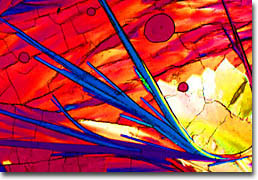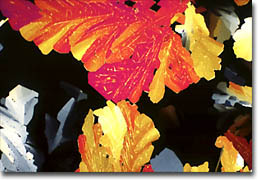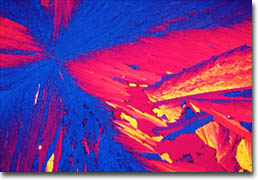|
The carbohydrate class of biochemicals includes starches, sugars, gums, and dextrins. These biochemicals share a common feature of being composed of carbon and water in equimolar amounts, hence the name carbohydrate. The simplest carbohydrates are the sugars, usually sweet in taste, that contain names ending with the suffix "ose." Sugars are generally considered to be comprised of three different classes of compounds, namely the monosaccharides, the monosaccharides, and the trisaccharides. Monosaccharides are simple sugars, and a disaccharide is composed of two of these compounds, minus a single water molecule. Trisaccharides, which consist of three monosaccharides, or hexoses, linked by glycosidic bonds, are quite rare compared to other sugar compounds, but can be found as raffinose in sugar beets, cottonseed, and molasses.

Maltose
The importance of sugars and other carbohydrates to life are undeniable. Plants absorb carbon dioxide from the atmosphere during photosynthesis. This substance is then "fixed" into carbohydrates, such as sugars, which are stored as starch or cellulose. In order to obtain necessary dietary carbohydrates, humans and other animals consume plants or other plant-eating animals. Through this sequence of events, plant-generated carbohydrates ultimately become the principal source of carbon in all animal tissues, including humans. Moreover, once in the body, sugars perform a wide range of functions, many of which have only been discovered in recent years. The important compounds, studies have shown, are involved with everything from the immune system, communication between cells, cell identification, and the progression of cancer. In light of these relatively new revelations, researchers are beginning to examine sugar structures and activities with increased vigor, many hoping that additional findings may help yield innovative therapeutic agents.

Glucose
The sugar that most people come into contact with on a daily basis is a form of refined, crystalline sucrose, a disaccharide consisting of one molecule of glucose and one molecule of fructose. Sucrose is present in most plants, but is found in the greatest amounts in sugarcane and sugar beets, which are the primary sources of the sugar sold in stores around the world. Sugarcane was the first of the two crops to be harvested for its sugar content (which ranges from 7 to 18 percent of its weight), the practice likely beginning during antiquity in the area known in modern times as New Guinea. The cultivation of this tall, perennial grass, scientifically known as Saccharum officinarum, did not begin in Europe, however, until some time during the Middle Ages when Arabs introduced the practice to Spain.

Sucrose
Heavy farming of the sugar beet (Beta vulgaris) as a source of sugar is an even later development. The practice essentially evolved out of French necessity during the Napoleonic Wars of the 1800s, when the British effectively shut down the trade route between the West Indies and France that had formerly supplied the country with abundant amounts of sugar. Due to the environmental conditions that it requires, sugar cane could not be grown in Europe, leading French inhabitants to seek another source of sugar that could be grown locally. The sugar beet, which is comprised of as much as 22 percent sugar (by weight), had been cultivated in temperate regions for many years as a vegetable and had been proven by Andreas Marggraf in 1747 to yield sugar experimentally. Thus, it was a prime choice for exploitation, and under Napoleon's influence, dozens of beet sugar operations were established in France, although many failed soon after his fall from power. Over time the industry regained its footing, and similar beet sugar facilities were eventually instituted in the United States and other parts of the world.

Galactose
The photomicrograph in our banner illustrates the unusual texture adopted by crystallites of the 6-carbon sugar glucose. Glucose is the major component in glycogen, the sugar storage macromolecule, and is the central molecule involved in the anaerobic glycolysis process. Though first isolated in 1747 from raisins, glucose did not receive its current name until many decades later, when Jean Dumas coined the moniker based on the Greek glycos, meaning "sugar" or "sweet." In addition to raisins, the substance may be found in a variety of other fruits as well as grains and honey. Glucose can also be found anywhere there is sucrose, since it comprises part of that sugar. Commercially, glucose is produced by the enzyme conversion of cornstarch and then is refined by ion-exchange demineralization. The sugar is widely employed as a sweetener in foods and soft drinks and is often added as an energy source to pet foods and animal feed.

Fructose
The widespread proliferation of sugar substitutes, which generally are unable to be metabolized and, therefore, only contribute a negligible number of calories to foods and beverages, is a relatively recent phenomenon. However, saccharin, which became the first artificial sweetener sold commercially, was discovered accidentally as early as 1879 by John Hopkins University faculty member Ira Remsen and a German graduate student, Constantin Fahlberg. Initially marketed to diabetics and other consumers suffering conditions that require a restricted sugar intake, saccharin has several hundred times the sweetening strength of ordinary table sugar (sucrose), but has an unusual aftertaste and has been linked in some studies to cancer development in rats. In 1937, a new group of artificial sweeteners, known as cyclamates, were developed, which were only about 30 times as sweet as sucrose, but these were banned in the late 1960s due to health concerns. Controversy has, in fact, surrounded most artificial sweeteners, including the highly prevalent aspartame, but many are still approved for use as additives in most countries.
|





